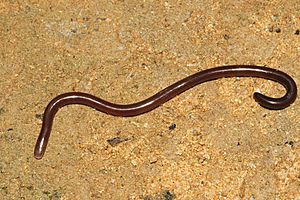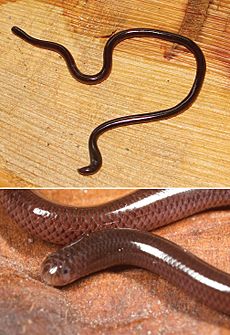Brahminy blind snake facts for kids
Quick facts for kids Indotyphlops braminus |
|
|---|---|
 |
|
| Scientific classification | |
| Genus: |
Indotyphlops
|
| Species: |
braminus
|
The brahminy blind snake (scientific name: Indotyphlops braminus) is a very small, non-venomous snake. It's often called the flowerpot snake because it can travel around the world hidden in plant pots! This snake looks a lot like an earthworm, but it's actually a reptile with tiny scales. It spends most of its life underground, burrowing through the soil. You might also hear it called the common blind snake or Hawaiian blind snake.
Contents
What Does It Look Like?
These snakes are usually about 2 to 4 inches (5-10 cm) long, but some can grow up to 6 inches (15 cm). This makes them the smallest known snake species! Their head and tail look very similar, and their head doesn't stand out from their body.
Unlike most snakes, the scales on their head look just like the scales on the rest of their body. Their eyes are tiny dots hidden under their head scales, making them almost completely blind. They can't see clear images, but they can tell the difference between light and dark. The tip of their tail has a small, pointed spur.
Their color can be charcoal gray, silver-gray, light yellow-beige, or even purplish. Their belly is usually lighter. Young snakes look similar to adults. These snakes can be slow-moving or quite active, quickly trying to hide in soil or leaves if they are in the light.
Where Do They Live?
The brahminy blind snake probably first came from Africa and Asia. But because they are so good at hiding in soil and plants, they have been accidentally carried by people to many other parts of the world. Now, you can find them in places like Australia, the Americas, and islands in the Pacific Ocean.
They live from sea level up to about 1,500 meters (almost a mile) high in some places.
Original Homes
In Africa, they are found in countries like Egypt, Kenya, South Africa, and Madagascar. In Asia, they live in places such as India, Sri Lanka, China, Thailand, and the Philippines. They are also found on many islands in Southeast Asia.
New Homes (Introduced)
These snakes have been introduced to many new places, sometimes to help control termites. In Australia, they are found in the northern parts. In the Pacific, they live on islands like Hawaii, Guam, and Fiji. In the Americas, you can find them in parts of the United States (like Florida, California, and Hawaii), Mexico, and some Caribbean islands. They have also been found in the Canary Islands and Malta.
What Is Their Home Like?
These snakes usually live in places where people also live or farm. They like to stay underground in nests made by ants and termites. You can also find them hiding under logs, wet leaves, stones, and in rich, moist soil in forests, jungles, old buildings, and even city gardens. They need soil that is moist and warm enough to survive.
What Do They Eat?
The brahminy blind snake loves to eat the eggs, larvae (baby insects), and pupae (young insects before they become adults) of ants and termites.
How Do They Have Babies?
This snake species is very special because it reproduces through something called parthenogenesis. This means that all the snakes found so far are female, and they don't need a male to have babies! They can lay eggs or sometimes give birth to live young. Each time, they can have up to eight babies, and all of them will be female and exactly like their mother.
See also
 In Spanish: Indotyphlops braminus para niños
In Spanish: Indotyphlops braminus para niños


